RMIT Financial Planning: Research and Application Assignment Report
VerifiedAdded on 2022/10/14
|10
|1990
|431
Report
AI Summary
This report provides an in-depth analysis of financial planning principles and practices. It begins by examining key economic indicators and their impact on client advice within the Australian context. The report then identifies and describes the roles of regulatory bodies in the financial services industry, including ASIC, RBA, Treasury, and APRA. It further explores the skills required for effective client engagement and building rapport, along with an assessment of managed funds, including their advantages, disadvantages, and suitability for different client demographics. The report also addresses ethical responsibilities, compliance tests for financial advisors, and issues facing the financial planning industry, concluding with a discussion of licensee requirements and regulations. This assignment fulfills the requirements of a Diploma of Financial Planning course at RMIT.

Running head: RESEARCH AND APPLICATION ASSIGNMENT
Research and Application Assignment
Name of the Student
Name of the University
Author’s note
Research and Application Assignment
Name of the Student
Name of the University
Author’s note
Paraphrase This Document
Need a fresh take? Get an instant paraphrase of this document with our AI Paraphraser
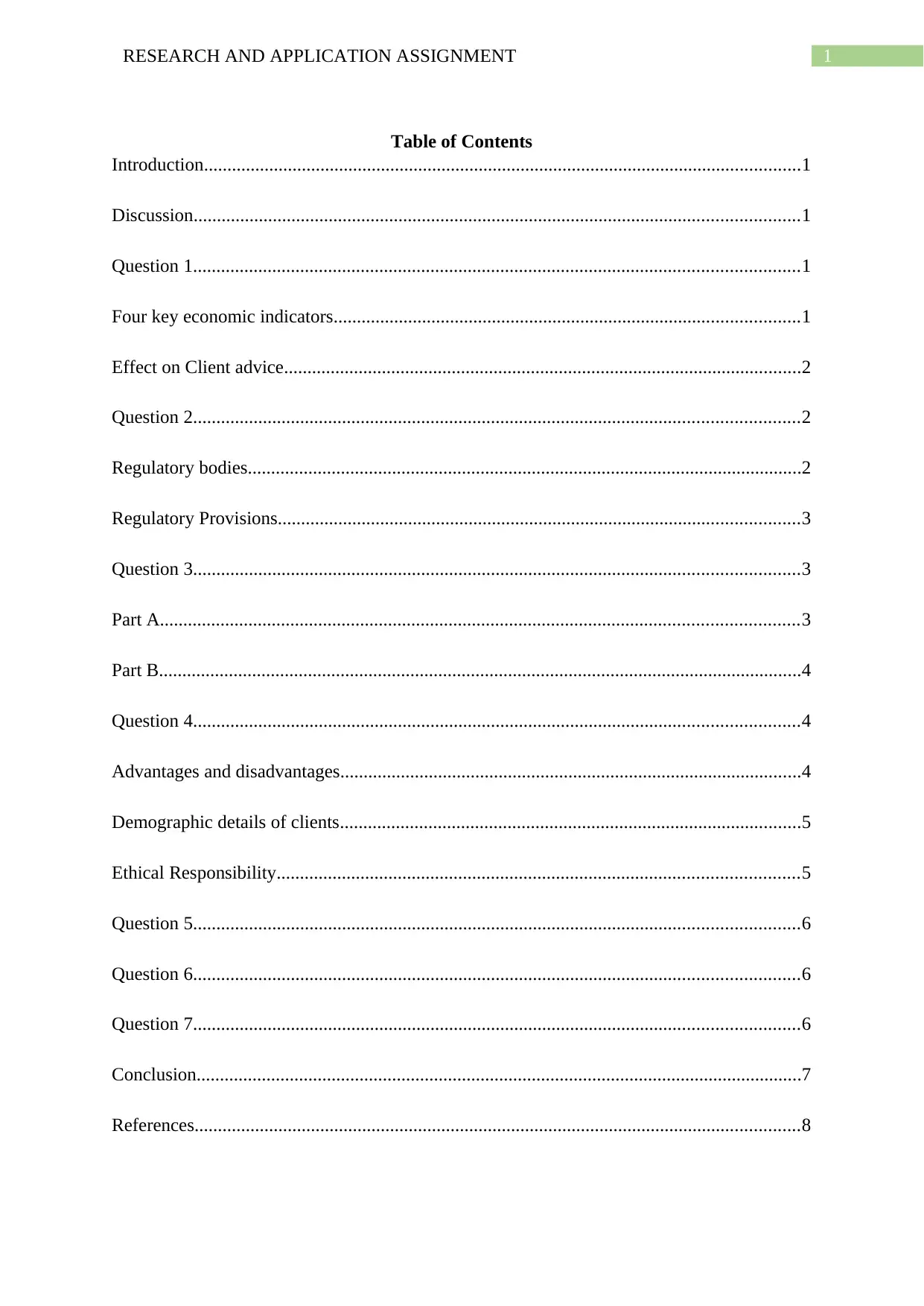
1RESEARCH AND APPLICATION ASSIGNMENT
Table of Contents
Introduction................................................................................................................................1
Discussion..................................................................................................................................1
Question 1..................................................................................................................................1
Four key economic indicators....................................................................................................1
Effect on Client advice...............................................................................................................2
Question 2..................................................................................................................................2
Regulatory bodies.......................................................................................................................2
Regulatory Provisions................................................................................................................3
Question 3..................................................................................................................................3
Part A.........................................................................................................................................3
Part B..........................................................................................................................................4
Question 4..................................................................................................................................4
Advantages and disadvantages...................................................................................................4
Demographic details of clients...................................................................................................5
Ethical Responsibility................................................................................................................5
Question 5..................................................................................................................................6
Question 6..................................................................................................................................6
Question 7..................................................................................................................................6
Conclusion..................................................................................................................................7
References..................................................................................................................................8
Table of Contents
Introduction................................................................................................................................1
Discussion..................................................................................................................................1
Question 1..................................................................................................................................1
Four key economic indicators....................................................................................................1
Effect on Client advice...............................................................................................................2
Question 2..................................................................................................................................2
Regulatory bodies.......................................................................................................................2
Regulatory Provisions................................................................................................................3
Question 3..................................................................................................................................3
Part A.........................................................................................................................................3
Part B..........................................................................................................................................4
Question 4..................................................................................................................................4
Advantages and disadvantages...................................................................................................4
Demographic details of clients...................................................................................................5
Ethical Responsibility................................................................................................................5
Question 5..................................................................................................................................6
Question 6..................................................................................................................................6
Question 7..................................................................................................................................6
Conclusion..................................................................................................................................7
References..................................................................................................................................8
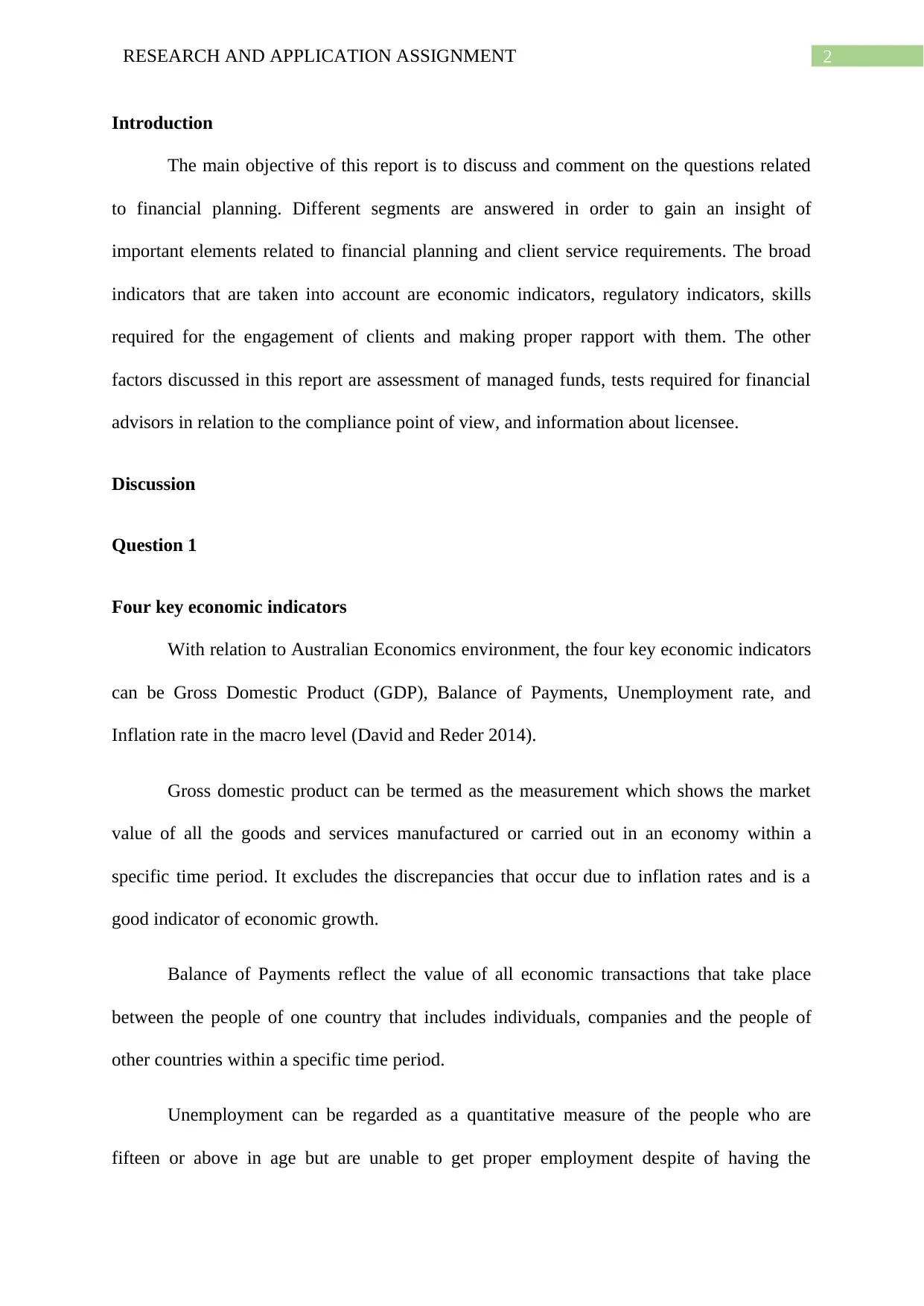
2RESEARCH AND APPLICATION ASSIGNMENT
Introduction
The main objective of this report is to discuss and comment on the questions related
to financial planning. Different segments are answered in order to gain an insight of
important elements related to financial planning and client service requirements. The broad
indicators that are taken into account are economic indicators, regulatory indicators, skills
required for the engagement of clients and making proper rapport with them. The other
factors discussed in this report are assessment of managed funds, tests required for financial
advisors in relation to the compliance point of view, and information about licensee.
Discussion
Question 1
Four key economic indicators
With relation to Australian Economics environment, the four key economic indicators
can be Gross Domestic Product (GDP), Balance of Payments, Unemployment rate, and
Inflation rate in the macro level (David and Reder 2014).
Gross domestic product can be termed as the measurement which shows the market
value of all the goods and services manufactured or carried out in an economy within a
specific time period. It excludes the discrepancies that occur due to inflation rates and is a
good indicator of economic growth.
Balance of Payments reflect the value of all economic transactions that take place
between the people of one country that includes individuals, companies and the people of
other countries within a specific time period.
Unemployment can be regarded as a quantitative measure of the people who are
fifteen or above in age but are unable to get proper employment despite of having the
Introduction
The main objective of this report is to discuss and comment on the questions related
to financial planning. Different segments are answered in order to gain an insight of
important elements related to financial planning and client service requirements. The broad
indicators that are taken into account are economic indicators, regulatory indicators, skills
required for the engagement of clients and making proper rapport with them. The other
factors discussed in this report are assessment of managed funds, tests required for financial
advisors in relation to the compliance point of view, and information about licensee.
Discussion
Question 1
Four key economic indicators
With relation to Australian Economics environment, the four key economic indicators
can be Gross Domestic Product (GDP), Balance of Payments, Unemployment rate, and
Inflation rate in the macro level (David and Reder 2014).
Gross domestic product can be termed as the measurement which shows the market
value of all the goods and services manufactured or carried out in an economy within a
specific time period. It excludes the discrepancies that occur due to inflation rates and is a
good indicator of economic growth.
Balance of Payments reflect the value of all economic transactions that take place
between the people of one country that includes individuals, companies and the people of
other countries within a specific time period.
Unemployment can be regarded as a quantitative measure of the people who are
fifteen or above in age but are unable to get proper employment despite of having the
⊘ This is a preview!⊘
Do you want full access?
Subscribe today to unlock all pages.

Trusted by 1+ million students worldwide
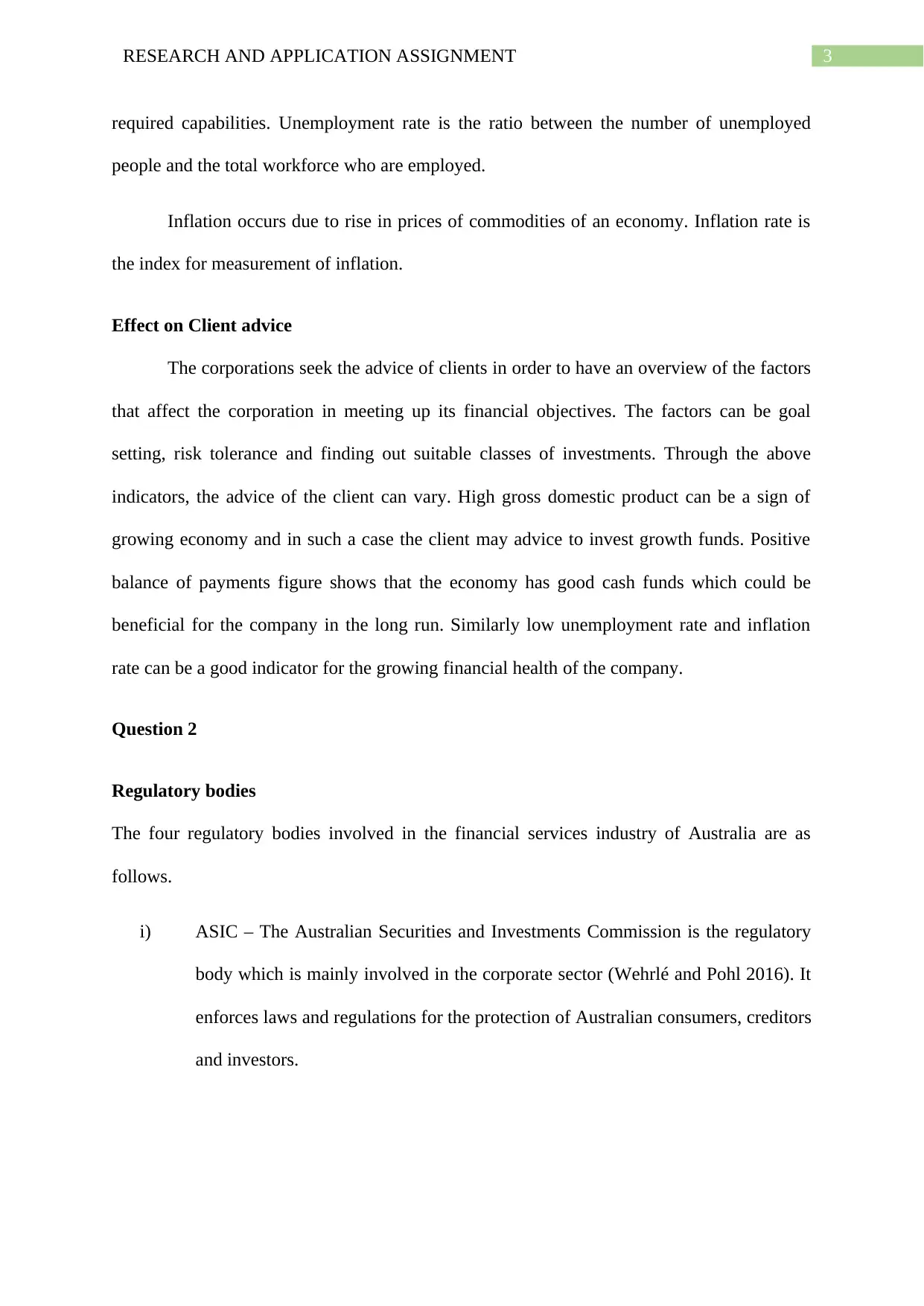
3RESEARCH AND APPLICATION ASSIGNMENT
required capabilities. Unemployment rate is the ratio between the number of unemployed
people and the total workforce who are employed.
Inflation occurs due to rise in prices of commodities of an economy. Inflation rate is
the index for measurement of inflation.
Effect on Client advice
The corporations seek the advice of clients in order to have an overview of the factors
that affect the corporation in meeting up its financial objectives. The factors can be goal
setting, risk tolerance and finding out suitable classes of investments. Through the above
indicators, the advice of the client can vary. High gross domestic product can be a sign of
growing economy and in such a case the client may advice to invest growth funds. Positive
balance of payments figure shows that the economy has good cash funds which could be
beneficial for the company in the long run. Similarly low unemployment rate and inflation
rate can be a good indicator for the growing financial health of the company.
Question 2
Regulatory bodies
The four regulatory bodies involved in the financial services industry of Australia are as
follows.
i) ASIC – The Australian Securities and Investments Commission is the regulatory
body which is mainly involved in the corporate sector (Wehrlé and Pohl 2016). It
enforces laws and regulations for the protection of Australian consumers, creditors
and investors.
required capabilities. Unemployment rate is the ratio between the number of unemployed
people and the total workforce who are employed.
Inflation occurs due to rise in prices of commodities of an economy. Inflation rate is
the index for measurement of inflation.
Effect on Client advice
The corporations seek the advice of clients in order to have an overview of the factors
that affect the corporation in meeting up its financial objectives. The factors can be goal
setting, risk tolerance and finding out suitable classes of investments. Through the above
indicators, the advice of the client can vary. High gross domestic product can be a sign of
growing economy and in such a case the client may advice to invest growth funds. Positive
balance of payments figure shows that the economy has good cash funds which could be
beneficial for the company in the long run. Similarly low unemployment rate and inflation
rate can be a good indicator for the growing financial health of the company.
Question 2
Regulatory bodies
The four regulatory bodies involved in the financial services industry of Australia are as
follows.
i) ASIC – The Australian Securities and Investments Commission is the regulatory
body which is mainly involved in the corporate sector (Wehrlé and Pohl 2016). It
enforces laws and regulations for the protection of Australian consumers, creditors
and investors.
Paraphrase This Document
Need a fresh take? Get an instant paraphrase of this document with our AI Paraphraser
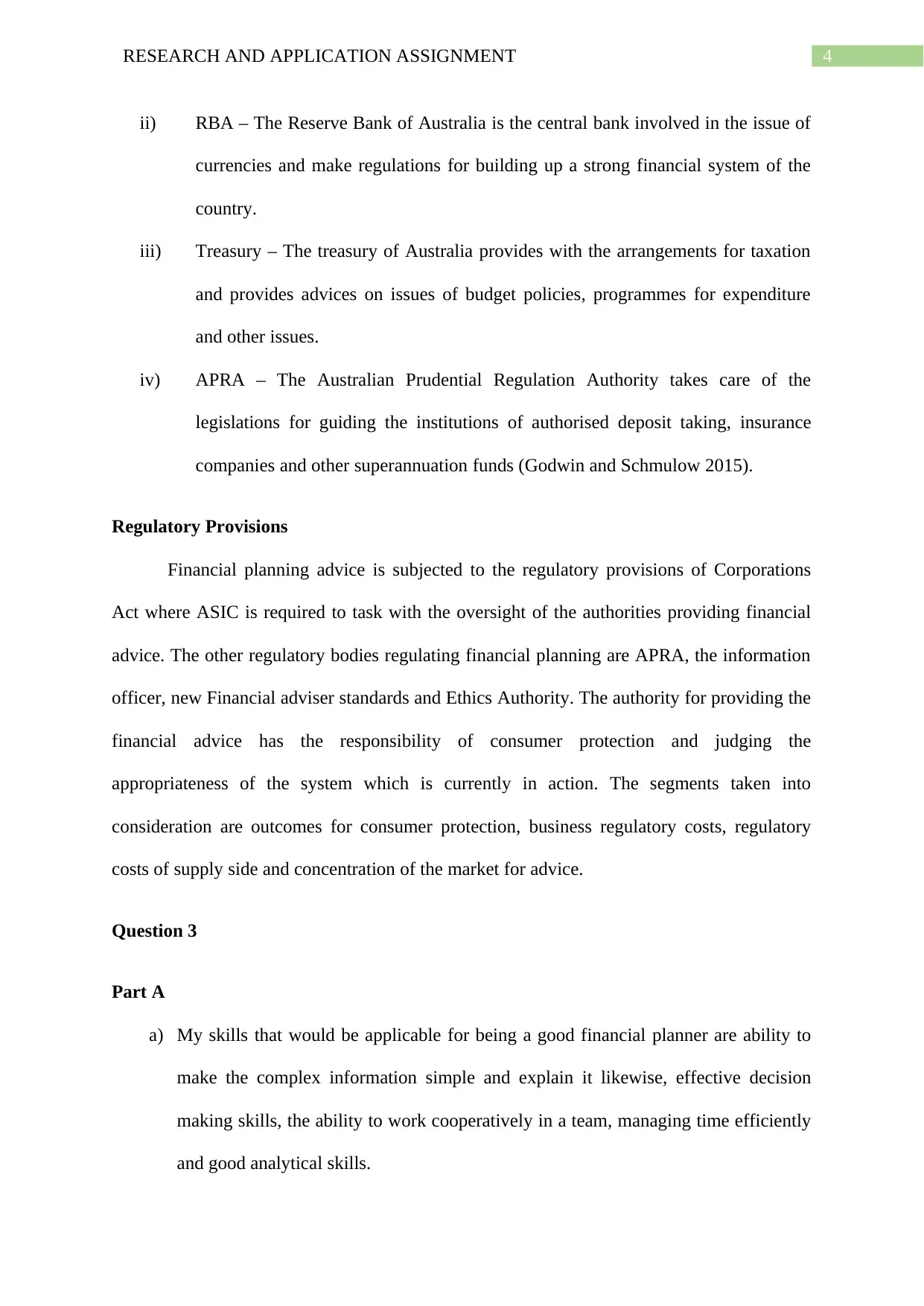
4RESEARCH AND APPLICATION ASSIGNMENT
ii) RBA – The Reserve Bank of Australia is the central bank involved in the issue of
currencies and make regulations for building up a strong financial system of the
country.
iii) Treasury – The treasury of Australia provides with the arrangements for taxation
and provides advices on issues of budget policies, programmes for expenditure
and other issues.
iv) APRA – The Australian Prudential Regulation Authority takes care of the
legislations for guiding the institutions of authorised deposit taking, insurance
companies and other superannuation funds (Godwin and Schmulow 2015).
Regulatory Provisions
Financial planning advice is subjected to the regulatory provisions of Corporations
Act where ASIC is required to task with the oversight of the authorities providing financial
advice. The other regulatory bodies regulating financial planning are APRA, the information
officer, new Financial adviser standards and Ethics Authority. The authority for providing the
financial advice has the responsibility of consumer protection and judging the
appropriateness of the system which is currently in action. The segments taken into
consideration are outcomes for consumer protection, business regulatory costs, regulatory
costs of supply side and concentration of the market for advice.
Question 3
Part A
a) My skills that would be applicable for being a good financial planner are ability to
make the complex information simple and explain it likewise, effective decision
making skills, the ability to work cooperatively in a team, managing time efficiently
and good analytical skills.
ii) RBA – The Reserve Bank of Australia is the central bank involved in the issue of
currencies and make regulations for building up a strong financial system of the
country.
iii) Treasury – The treasury of Australia provides with the arrangements for taxation
and provides advices on issues of budget policies, programmes for expenditure
and other issues.
iv) APRA – The Australian Prudential Regulation Authority takes care of the
legislations for guiding the institutions of authorised deposit taking, insurance
companies and other superannuation funds (Godwin and Schmulow 2015).
Regulatory Provisions
Financial planning advice is subjected to the regulatory provisions of Corporations
Act where ASIC is required to task with the oversight of the authorities providing financial
advice. The other regulatory bodies regulating financial planning are APRA, the information
officer, new Financial adviser standards and Ethics Authority. The authority for providing the
financial advice has the responsibility of consumer protection and judging the
appropriateness of the system which is currently in action. The segments taken into
consideration are outcomes for consumer protection, business regulatory costs, regulatory
costs of supply side and concentration of the market for advice.
Question 3
Part A
a) My skills that would be applicable for being a good financial planner are ability to
make the complex information simple and explain it likewise, effective decision
making skills, the ability to work cooperatively in a team, managing time efficiently
and good analytical skills.
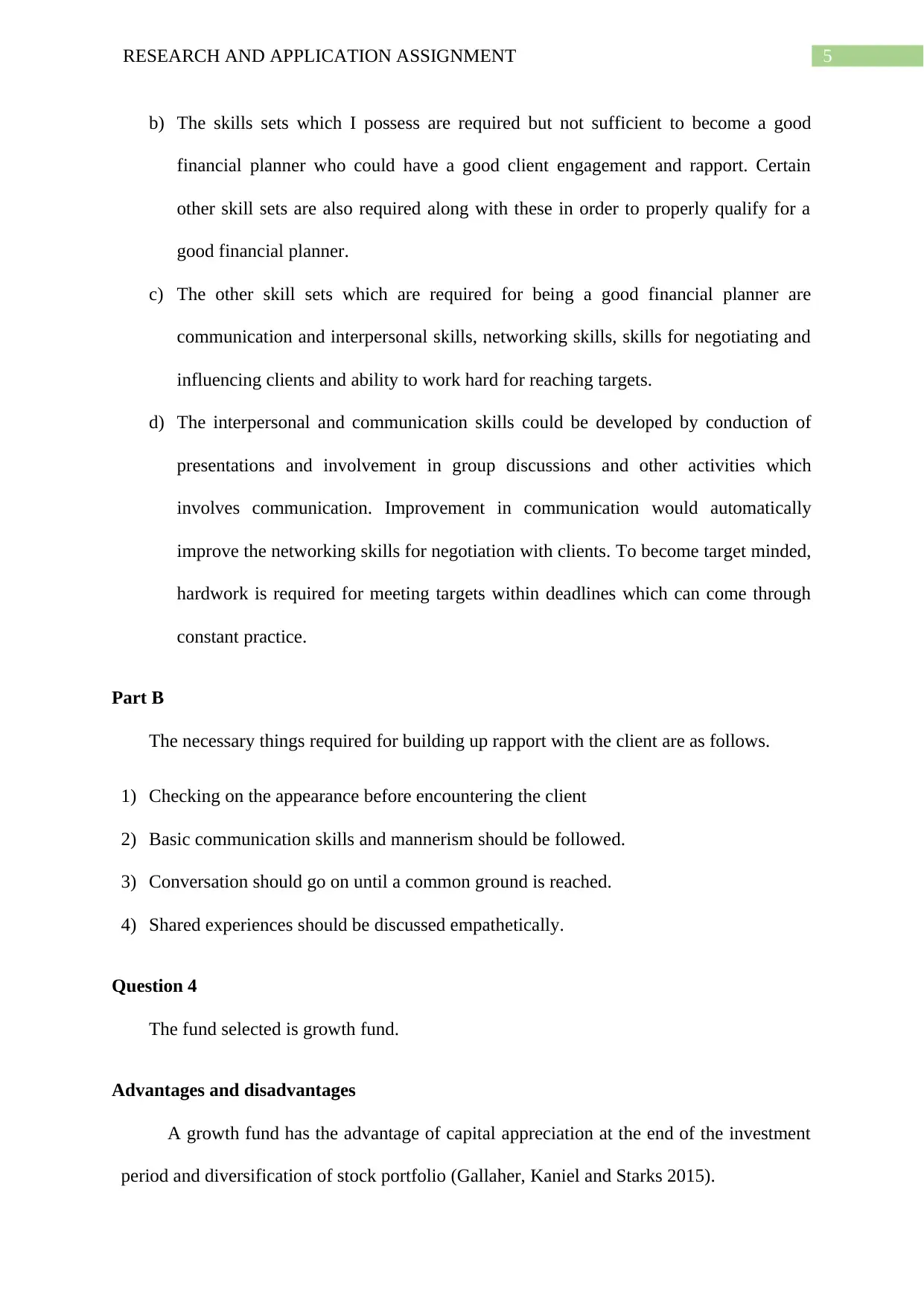
5RESEARCH AND APPLICATION ASSIGNMENT
b) The skills sets which I possess are required but not sufficient to become a good
financial planner who could have a good client engagement and rapport. Certain
other skill sets are also required along with these in order to properly qualify for a
good financial planner.
c) The other skill sets which are required for being a good financial planner are
communication and interpersonal skills, networking skills, skills for negotiating and
influencing clients and ability to work hard for reaching targets.
d) The interpersonal and communication skills could be developed by conduction of
presentations and involvement in group discussions and other activities which
involves communication. Improvement in communication would automatically
improve the networking skills for negotiation with clients. To become target minded,
hardwork is required for meeting targets within deadlines which can come through
constant practice.
Part B
The necessary things required for building up rapport with the client are as follows.
1) Checking on the appearance before encountering the client
2) Basic communication skills and mannerism should be followed.
3) Conversation should go on until a common ground is reached.
4) Shared experiences should be discussed empathetically.
Question 4
The fund selected is growth fund.
Advantages and disadvantages
A growth fund has the advantage of capital appreciation at the end of the investment
period and diversification of stock portfolio (Gallaher, Kaniel and Starks 2015).
b) The skills sets which I possess are required but not sufficient to become a good
financial planner who could have a good client engagement and rapport. Certain
other skill sets are also required along with these in order to properly qualify for a
good financial planner.
c) The other skill sets which are required for being a good financial planner are
communication and interpersonal skills, networking skills, skills for negotiating and
influencing clients and ability to work hard for reaching targets.
d) The interpersonal and communication skills could be developed by conduction of
presentations and involvement in group discussions and other activities which
involves communication. Improvement in communication would automatically
improve the networking skills for negotiation with clients. To become target minded,
hardwork is required for meeting targets within deadlines which can come through
constant practice.
Part B
The necessary things required for building up rapport with the client are as follows.
1) Checking on the appearance before encountering the client
2) Basic communication skills and mannerism should be followed.
3) Conversation should go on until a common ground is reached.
4) Shared experiences should be discussed empathetically.
Question 4
The fund selected is growth fund.
Advantages and disadvantages
A growth fund has the advantage of capital appreciation at the end of the investment
period and diversification of stock portfolio (Gallaher, Kaniel and Starks 2015).
⊘ This is a preview!⊘
Do you want full access?
Subscribe today to unlock all pages.

Trusted by 1+ million students worldwide
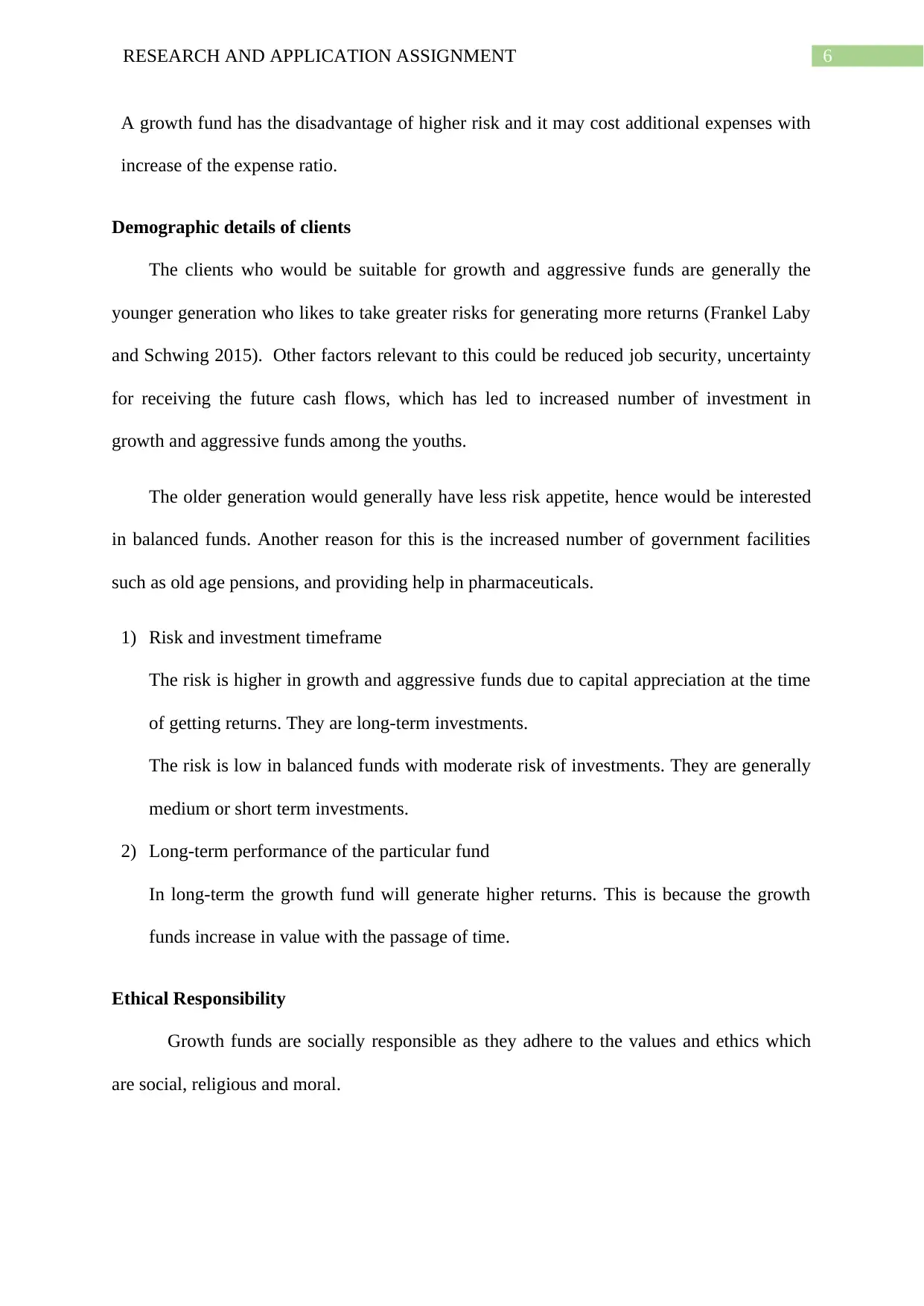
6RESEARCH AND APPLICATION ASSIGNMENT
A growth fund has the disadvantage of higher risk and it may cost additional expenses with
increase of the expense ratio.
Demographic details of clients
The clients who would be suitable for growth and aggressive funds are generally the
younger generation who likes to take greater risks for generating more returns (Frankel Laby
and Schwing 2015). Other factors relevant to this could be reduced job security, uncertainty
for receiving the future cash flows, which has led to increased number of investment in
growth and aggressive funds among the youths.
The older generation would generally have less risk appetite, hence would be interested
in balanced funds. Another reason for this is the increased number of government facilities
such as old age pensions, and providing help in pharmaceuticals.
1) Risk and investment timeframe
The risk is higher in growth and aggressive funds due to capital appreciation at the time
of getting returns. They are long-term investments.
The risk is low in balanced funds with moderate risk of investments. They are generally
medium or short term investments.
2) Long-term performance of the particular fund
In long-term the growth fund will generate higher returns. This is because the growth
funds increase in value with the passage of time.
Ethical Responsibility
Growth funds are socially responsible as they adhere to the values and ethics which
are social, religious and moral.
A growth fund has the disadvantage of higher risk and it may cost additional expenses with
increase of the expense ratio.
Demographic details of clients
The clients who would be suitable for growth and aggressive funds are generally the
younger generation who likes to take greater risks for generating more returns (Frankel Laby
and Schwing 2015). Other factors relevant to this could be reduced job security, uncertainty
for receiving the future cash flows, which has led to increased number of investment in
growth and aggressive funds among the youths.
The older generation would generally have less risk appetite, hence would be interested
in balanced funds. Another reason for this is the increased number of government facilities
such as old age pensions, and providing help in pharmaceuticals.
1) Risk and investment timeframe
The risk is higher in growth and aggressive funds due to capital appreciation at the time
of getting returns. They are long-term investments.
The risk is low in balanced funds with moderate risk of investments. They are generally
medium or short term investments.
2) Long-term performance of the particular fund
In long-term the growth fund will generate higher returns. This is because the growth
funds increase in value with the passage of time.
Ethical Responsibility
Growth funds are socially responsible as they adhere to the values and ethics which
are social, religious and moral.
Paraphrase This Document
Need a fresh take? Get an instant paraphrase of this document with our AI Paraphraser

7RESEARCH AND APPLICATION ASSIGNMENT
Question 5
The tests to be considered appropriate for the financial advisors for ensuring
compliance within the organisation could be compliance and ethics governance and
regulatory insight (Dimmock, Gerken and Graham 2018). Compliance and ethics governance
relates to ethical practice within the organisation and being in accordance with the guidelines
and specifications. Regulatory insight is the process of having a complete picture of the
regulations governing the organisation in order follow them properly.
Question 6
The issues faced by financial planning industry are as follows.
a) Investment management
b) Tax planning
c) Managing client expectations
d) Group support
e) Constant staying in touch with the client
f) Market volatility
To mitigate investment issues the funds should be properly analysed. Tax planning
could be mitigated by ensuring proper support from taxation experts. Lim et al. 2014. Clients
expectations could be managed by proper discussion and meeting with the client. Group
support could be improved by ensuring an effective team work. Staying in constant touch
with the client can be helped by having a person who could act as a mediator in the process.
Question 7
Licensees were given for a transitional period of two years to the businesses for
adjustments of their business operations until 10 March 2004. From 11 March 2004, the
Australian Financial Services License (AFSL) would be required for anyone involved in
Question 5
The tests to be considered appropriate for the financial advisors for ensuring
compliance within the organisation could be compliance and ethics governance and
regulatory insight (Dimmock, Gerken and Graham 2018). Compliance and ethics governance
relates to ethical practice within the organisation and being in accordance with the guidelines
and specifications. Regulatory insight is the process of having a complete picture of the
regulations governing the organisation in order follow them properly.
Question 6
The issues faced by financial planning industry are as follows.
a) Investment management
b) Tax planning
c) Managing client expectations
d) Group support
e) Constant staying in touch with the client
f) Market volatility
To mitigate investment issues the funds should be properly analysed. Tax planning
could be mitigated by ensuring proper support from taxation experts. Lim et al. 2014. Clients
expectations could be managed by proper discussion and meeting with the client. Group
support could be improved by ensuring an effective team work. Staying in constant touch
with the client can be helped by having a person who could act as a mediator in the process.
Question 7
Licensees were given for a transitional period of two years to the businesses for
adjustments of their business operations until 10 March 2004. From 11 March 2004, the
Australian Financial Services License (AFSL) would be required for anyone involved in
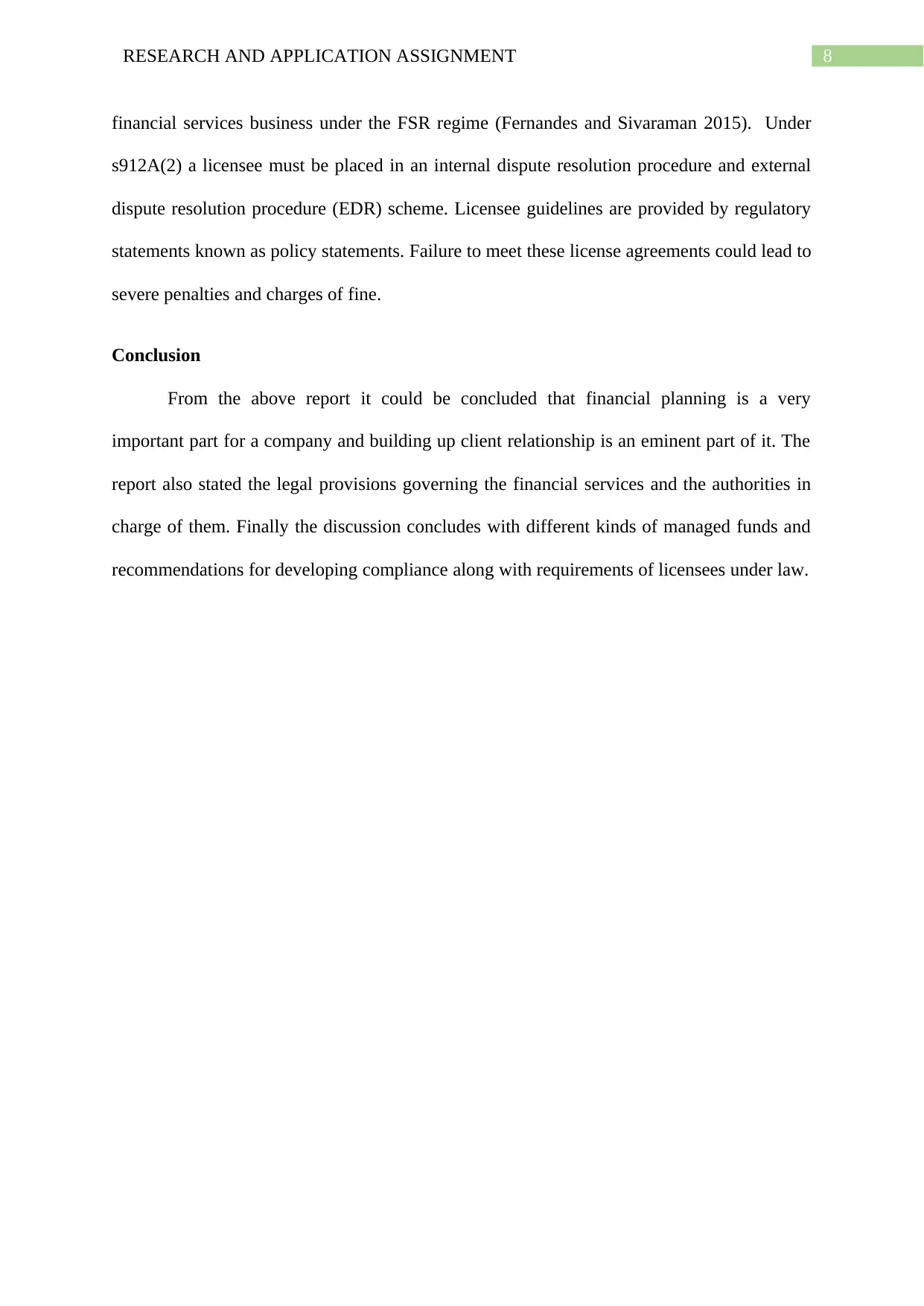
8RESEARCH AND APPLICATION ASSIGNMENT
financial services business under the FSR regime (Fernandes and Sivaraman 2015). Under
s912A(2) a licensee must be placed in an internal dispute resolution procedure and external
dispute resolution procedure (EDR) scheme. Licensee guidelines are provided by regulatory
statements known as policy statements. Failure to meet these license agreements could lead to
severe penalties and charges of fine.
Conclusion
From the above report it could be concluded that financial planning is a very
important part for a company and building up client relationship is an eminent part of it. The
report also stated the legal provisions governing the financial services and the authorities in
charge of them. Finally the discussion concludes with different kinds of managed funds and
recommendations for developing compliance along with requirements of licensees under law.
financial services business under the FSR regime (Fernandes and Sivaraman 2015). Under
s912A(2) a licensee must be placed in an internal dispute resolution procedure and external
dispute resolution procedure (EDR) scheme. Licensee guidelines are provided by regulatory
statements known as policy statements. Failure to meet these license agreements could lead to
severe penalties and charges of fine.
Conclusion
From the above report it could be concluded that financial planning is a very
important part for a company and building up client relationship is an eminent part of it. The
report also stated the legal provisions governing the financial services and the authorities in
charge of them. Finally the discussion concludes with different kinds of managed funds and
recommendations for developing compliance along with requirements of licensees under law.
⊘ This is a preview!⊘
Do you want full access?
Subscribe today to unlock all pages.

Trusted by 1+ million students worldwide
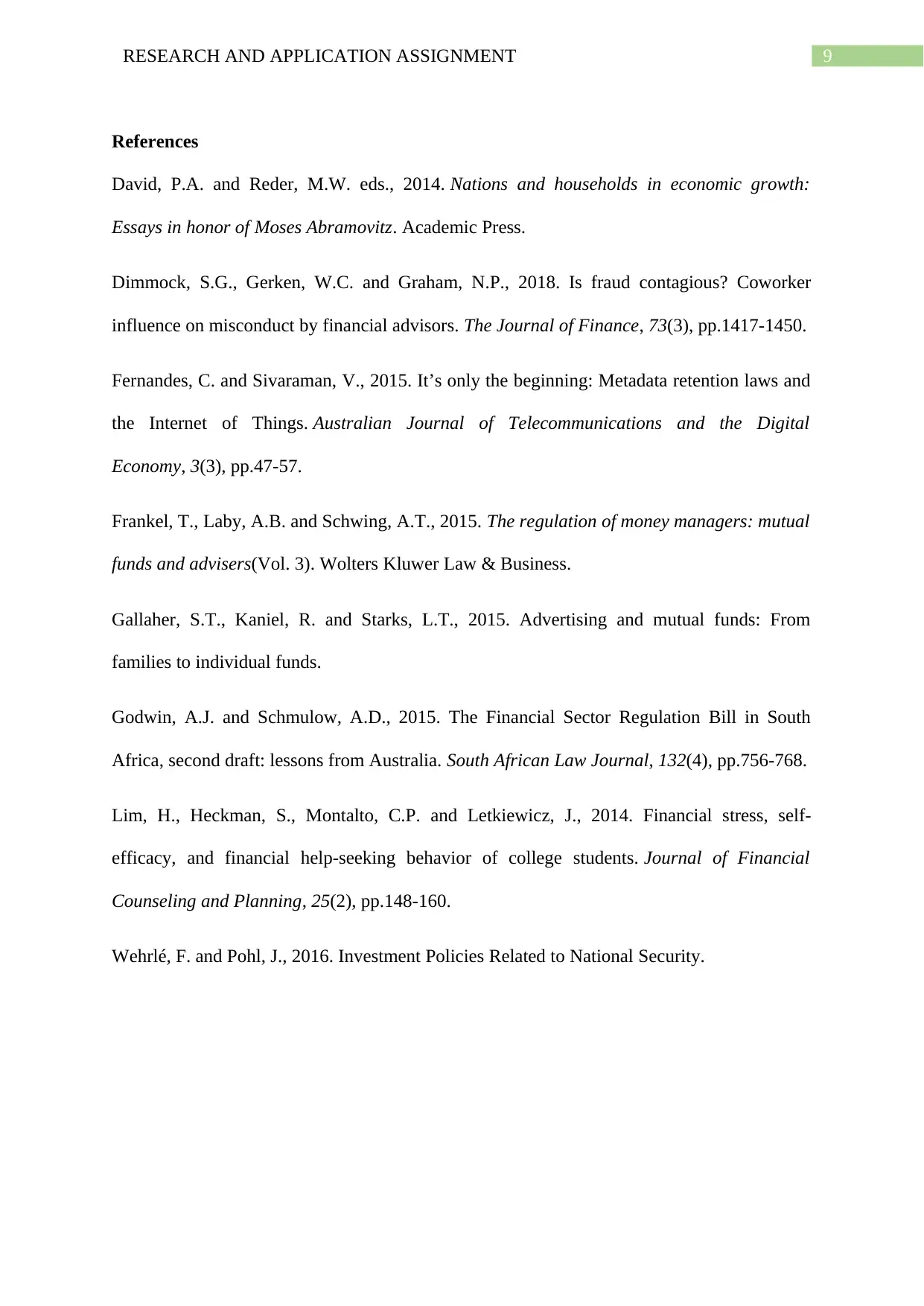
9RESEARCH AND APPLICATION ASSIGNMENT
References
David, P.A. and Reder, M.W. eds., 2014. Nations and households in economic growth:
Essays in honor of Moses Abramovitz. Academic Press.
Dimmock, S.G., Gerken, W.C. and Graham, N.P., 2018. Is fraud contagious? Coworker
influence on misconduct by financial advisors. The Journal of Finance, 73(3), pp.1417-1450.
Fernandes, C. and Sivaraman, V., 2015. It’s only the beginning: Metadata retention laws and
the Internet of Things. Australian Journal of Telecommunications and the Digital
Economy, 3(3), pp.47-57.
Frankel, T., Laby, A.B. and Schwing, A.T., 2015. The regulation of money managers: mutual
funds and advisers(Vol. 3). Wolters Kluwer Law & Business.
Gallaher, S.T., Kaniel, R. and Starks, L.T., 2015. Advertising and mutual funds: From
families to individual funds.
Godwin, A.J. and Schmulow, A.D., 2015. The Financial Sector Regulation Bill in South
Africa, second draft: lessons from Australia. South African Law Journal, 132(4), pp.756-768.
Lim, H., Heckman, S., Montalto, C.P. and Letkiewicz, J., 2014. Financial stress, self-
efficacy, and financial help-seeking behavior of college students. Journal of Financial
Counseling and Planning, 25(2), pp.148-160.
Wehrlé, F. and Pohl, J., 2016. Investment Policies Related to National Security.
References
David, P.A. and Reder, M.W. eds., 2014. Nations and households in economic growth:
Essays in honor of Moses Abramovitz. Academic Press.
Dimmock, S.G., Gerken, W.C. and Graham, N.P., 2018. Is fraud contagious? Coworker
influence on misconduct by financial advisors. The Journal of Finance, 73(3), pp.1417-1450.
Fernandes, C. and Sivaraman, V., 2015. It’s only the beginning: Metadata retention laws and
the Internet of Things. Australian Journal of Telecommunications and the Digital
Economy, 3(3), pp.47-57.
Frankel, T., Laby, A.B. and Schwing, A.T., 2015. The regulation of money managers: mutual
funds and advisers(Vol. 3). Wolters Kluwer Law & Business.
Gallaher, S.T., Kaniel, R. and Starks, L.T., 2015. Advertising and mutual funds: From
families to individual funds.
Godwin, A.J. and Schmulow, A.D., 2015. The Financial Sector Regulation Bill in South
Africa, second draft: lessons from Australia. South African Law Journal, 132(4), pp.756-768.
Lim, H., Heckman, S., Montalto, C.P. and Letkiewicz, J., 2014. Financial stress, self-
efficacy, and financial help-seeking behavior of college students. Journal of Financial
Counseling and Planning, 25(2), pp.148-160.
Wehrlé, F. and Pohl, J., 2016. Investment Policies Related to National Security.
1 out of 10
Related Documents
Your All-in-One AI-Powered Toolkit for Academic Success.
+13062052269
info@desklib.com
Available 24*7 on WhatsApp / Email
![[object Object]](/_next/static/media/star-bottom.7253800d.svg)
Unlock your academic potential
Copyright © 2020–2025 A2Z Services. All Rights Reserved. Developed and managed by ZUCOL.





